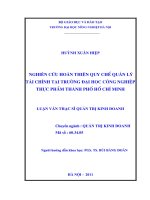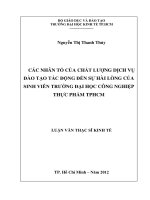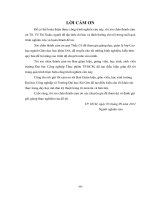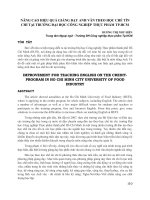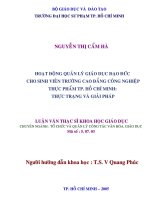Teacher’s grammar English - Trường Đại học Công nghiệp Thực phẩm Tp. Hồ Chí Minh
Bạn đang xem bản rút gọn của tài liệu. Xem và tải ngay bản đầy đủ của tài liệu tại đây (249.32 KB, 20 trang )
<span class='text_page_counter'>(1)</span><div class='page_container' data-page=1></div>
<span class='text_page_counter'>(2)</span><div class='page_container' data-page=2></div>
<span class='text_page_counter'>(3)</span><div class='page_container' data-page=3>
<b>The Teacher’s Grammar Book</b>
<b>Second Edition</b>
James D. Williams
<i>Soka University</i>
LAWRENCE ERLBAUM ASSOCIATES, PUBLISHERS
</div>
<span class='text_page_counter'>(4)</span><div class='page_container' data-page=4>
Copyright © 2005 by Lawrence Erlbaum Associates, Inc.
All rights reserved. No part of this book may be reproduced in any form,
by photostat, microform, retrieval system, or any other means, without
prior written permission of the publisher.
Lawrence Erlbaum Associates, Inc., Publishers
10 Industrial Avenue
Mahwah, New Jersey 07430
www.erlbaum.com
Cover design by Kathryn Houghtaling Lacey
<b>Library of Congress Cataloging-in-Publication Data</b>
Williams, James D. (James Dale), 1949–
The teacher's grammar book / James D. Williams.—2nd ed.
p. cm.
Includes bibliographical references and index.
ISBN 0-8058-5221-2 (pbk. : alk. paper)
1. English language—Grammar. 2. English language—Grammar—
Study and teaching. I. Title.
PE1112.W46 2005
428.2—dc22 2004056421
CIP
Books published by Lawrence Erlbaum Associates are printed on acid-free
paper, and their bindings are chosen for strength and durability.
Printed in the United States of America
</div>
<span class='text_page_counter'>(5)</span><div class='page_container' data-page=5>
<b>Contents</b>
<b>Preface</b> <b>ix</b>
<b>Acknowledgments</b> <b>xiii</b>
<b>1</b>
<b>A Short History of Grammar</b> <b>1</b>Agreeing on a Definition <i>1</i>
Greek Beginnings <i>2</i>
Grammar in Rome <i>5</i>
Grammar in the Middle Ages <i>7</i>
The Age of Enlightenment <i>9</i>
The Age of Reason <i>12</i>
Modern Grammars <i>15</i>
<b>2</b>
<b>Teaching Grammar</b> <b>17</b>Recognizing the Challenges <i>17</i>
Learning Outcomes <i>19</i>
Grammar and Writing <i>23</i>
Why Teach Grammar? <i>40</i>
Best Practices <i>41</i>
Suggested Activities <i>47</i>
</div>
<span class='text_page_counter'>(6)</span><div class='page_container' data-page=6>
<b>3</b>
<b>Traditional Grammar</b> <b>50</b>Prescriptive Grammar in Our Schools <i>50</i>
Form and Function in Grammar <i>53</i>
Subjects and Predicates <i>54</i>
Nouns <i>59</i>
Pronouns <i>60</i>
Verbs <i>70</i>
Modifiers <i>77</i>
Function Words <i>82</i>
<b>4</b>
<b>Phrase Structure Grammar</b> <b>97</b>From the Universal to the Particular <i>97</i>
Phrase–Structure Rules <i>101</i>
Tree Diagrams <i>107</i>
Coordination <i>114</i>
Progressive Verb Forms <i>130</i>
Perfect Verb Forms <i>133</i>
Possessives <i>133</i>
Restrictive and Nonrestrictive Modification <i>134</i>
Subordinate Clauses <i>136</i>
Complement Clauses <i>139</i>
Relative Clauses <i>142</i>
Negatives <i>152</i>
Nonfinite Verb Forms <i>154</i>
Summary of Phrase–Structure Rules <i>156</i>
<b>5</b>
<b>Noam Chomsky and Grammar</b> <b>161</b>The Chomsky Revolution <i>161</i>
Deep Structure and Surface Structure <i>166</i>
The Basics of Transformation Rules <i>169</i>
Relative Clause Formation <i>174</i>
The Minimalist Program <i>162</i>
A Critique of the Minimalist Program <i>191</i>
<b>6</b>
<b>Cognitive Grammar</b> <b>197</b>What Is Cognitive Grammar? <i>197</i>
Modularity <i>198</i>
Determining Meaning <i>199</i>
Cognitive Grammar and Language Acquisition <i>206</i>
</div>
<span class='text_page_counter'>(7)</span><div class='page_container' data-page=7>
<b>7</b>
<b>Dialects</b> <b>220</b>What Is a Dialect? <i>220</i>
How Do Dialects Develop? <i>221</i>
Students and Dialects <i>224</i>
Slang <i>228</i>
Development of a Prestige Dialect <i>230</i>
Nonstandard Dialects <i>230</i>
Dialects and Education <i>233</i>
Black English <i>236</i>
Chicano English <i>245</i>
Chicano English Grammar <i>246</i>
Chicano English in the Classroom <i>248</i>
Spanglish <i>250</i>
Code Switching <i>250</i>
<b>References</b> <b>254</b>
<b>Index</b> <b>265</b>
</div>
<span class='text_page_counter'>(8)</span><div class='page_container' data-page=8>
<b>Preface</b>
<i>The Teacher’s Grammar Book</i>is designed for students who are preparing to
be-come English or language arts teachers, as well as for credentialed teachers
who want to know more about grammar. Most grammar books focus on
termi-nology. Some add a discussion of the connection between grammar and
writ-ing.<i>The Teacher’s Grammar Book,</i> however, is different. Certainly, it treats
terminology thoroughly, but it is far more than just a list of grammar terms. It is
not a handbook and was never intended to be one.<i>The Teacher’s Grammar</i>
<i>Book</i> was designed to offer an easy-to-use guide to teaching methods and
grammar and usage questions, a combination that has not been readily
avail-able before. In addition, it provides an overview of English grammar that is
in-formed not only by historical developments in the field but also by a variety of
pedagogical, research, and philosophical issues that underlie grammar and our
efforts to understand grammar, language, writing, and teaching. Out of this
wide-ranging exploration emerges the view that a teacher’s choice of grammar
reflects philosophical and pedagogical orientations that influence both the
con-tent and the methods of language arts instruction.
<i>The Teacher’s Grammar Book</i>grew out of my experience teaching grammar
and composition methods courses to education students since 1981. What I
dis-covered early in my career is that large numbers of prospective teachers do not
feel confident about their knowledge of English grammar. They experience a
certain degree of anxiety as a result. Most have recognized that they will be
re-quired to teach grammar—and they aren’t happy about it. Many have had bad
experiences with grammar in the past. They “didn’t get it,” or, sadder still, they
“just didn’t like it.” Nearly all are surprised when, a few weeks into my
gram-mar courses, they discover not only that they are “getting it” but that gramgram-mar is
</div>
<span class='text_page_counter'>(9)</span><div class='page_container' data-page=9>
actually fun.<i>The Teacher’s Grammar Book</i>aims to take readers on a similar
voyage of discovery.
<b>What’s New in the Second Edition</b>
The many teachers and students who used the first edition of<i>The Teacher’s</i>
<i>Grammar Book</i>provided various suggestions over the years intended to make
the text better. I’ve tried to incorporate their suggestions into the second edition
as much as possible, and I hope they are happy with the result of this indirect
collaboration. In many respects, the finished product is significantly different
from the original. The more important changes are:
• A new chapter providing a short history of grammar and its role in education.
• A new chapter on teaching grammar that examines not only the challenges
teachers face but also what research, theory, and classroom experience tell us
constitutes “best practices.”
• A significant reduction in the formalism associated with phrase structure
grammar so as to focus more on the descriptive goals of this approach to
lan-guage analysis.
• A complete revision of the chapter on transformational–generative grammar
that significantly reduces the discussion of transformation rules and tree
dia-grams so as to focus more on other features of this approach, such as its
influ-ence on teaching and psychology; also new is a summary of the model—the
minimalist program—that Noam Chomsky developed to replace
trans-formational–generative grammar.
• A complete revision of the chapter on cognitive grammar that not only makes
the discussion more current but also more detailed, addressing how cognitive
grammar provides insight into common problems associated with teaching
writing, such as creating meaning and errors in language.
• A thorough revision of the chapter on dialects to make it both more current
and more detailed; the discussion of Chicano English is significantly
ex-panded, and new in this edition is a brief analysis of Spanglish and an
explo-ration of code switching.
• Also new is the focus on teaching grammar and language as a thread that
winds through each chapter, making the text more thoroughly a tool to help
teachers meet the challenge of grammar instruction.
<i><b>Chapter One.</b></i> The first chapter offers a brief history of grammar in the
Western tradition. Although there are some interesting stories to tell about the
study of grammar in places like India, China, and the Middle East, they are not
very relevant to American public education, based as it is on Greek and Roman
models. The goal of this chapter, therefore, is to give readers a sense of the place
</div>
<span class='text_page_counter'>(10)</span><div class='page_container' data-page=10>
grammar has held in Western education since the days of Plato and Aristotle so
that they can better understand and appreciate why we expect students to learn
something about the English language.
<i><b>Chapter Two.</b></i> Chapter 2 explores various approaches to teaching
gram-mar, and in many respects it is central to developing an effective classroom
methodology. There are many different ways to teach grammar, and this
chap-ter examines the most common, assessing their strengths and weaknesses with
the aim of identifying best practices.
Central to this chapter is the section on grammar and writing. Most teachers
and many textbooks, such as Weaver’s (1996)<i>Teaching Grammar in Context</i>
and Noden’s (1999)<i>Image Grammar: Using Grammatical Structures to Teach</i>
<i>Writing,</i>advocate teaching grammar in the context of writing. However, few
recognize the difficulties and faulty assumptions inherent in this approach as it
usually is applied. Emphasizing the linguistic perspective that informs the
en-tire book, this section makes an important distinction between<i>grammar</i>and
<i>usage</i>, explaining why most of the sentence errors we see in student writing are
not problems of grammar but rather problems of usage. An important feature of
<i>The Teacher’s Grammar Book</i>are the<b>Usage Notes</b>that appear at key points to
explain a wide range of common usage problems. Finally, the chapter examines
existing research and explores the most pedagogically sound ways to link
grammar and writing.
<i><b>Chapter Three.</b></i> Although chapter 2 is important for every
English/lan-guage arts teacher, chapter 3, “Traditional Grammar,” may be even more
im-portant because it provides the foundation for actually teaching grammar. The
subsequent chapters are built on this foundation, and together they will
elimi-nate any lack of confidence readers may have about their knowledge of
gram-mar. The chapter begins by introducing basic grammatical terms and
explaining their role in language study. It does not assume that readers have any
significant knowledge of grammar at all so as to create a comfortable space for
learning. Taking a standard approach, grammar is divided into two categories
of analysis,<i>form</i>and<i>function.</i>
Chapter 3 also builds on the grammar/usage distinction by introducing a
fundamental feature of modern language study—<i>appropriateness conditions</i>.
Based in part on Hymes’ (1971) principles of communicative competence,
ap-propriateness conditions contextualize language use and allow students to
un-derstand more thoroughly the factors that make writing different from speech
and that enable us to recognize that the language we use when talking with
friends over pizza and beer will be different from the language we use during a
</div>
<span class='text_page_counter'>(11)</span><div class='page_container' data-page=11>
job interview. In addition, chapter 3 examines traditional grammar’s
prescrip-tive approach to language study and explores the implications for teaching.
<i><b>Chapter Four.</b></i> Chapter 4 introduces phrase–structure grammar and
ex-plains how it emerged during the early part of the 20th century as an alternative
to traditional grammar. Because phrase–structure grammar provides the
ana-lytical basis for all modern grammars, the chapter devotes considerable
atten-tion to helping students understand phrase–structure notaatten-tion. The primary
focus, however, is on understanding the<i>descriptive,</i>as opposed to the<i></i>
<i>prescrip-tive,</i>nature of phrase structure and how this orientation is central to
differenti-ating modern grammars from traditional grammar.
<i><b>Chapter Five.</b></i> Chapter 5 introduces transformational–generative (T–G)
grammar as an historical evolution of the work in phrase structure. Many
stu-dents find T–G challenging, and others resist its complexities by arguing that it
is irrelevant to teaching high school language arts. They often are put off by the
fact that T–G grammar has undergone numerous changes over the years.
Nev-ertheless, in the United States, T–G grammar remains an influential tool for
an-alyzing language and therefore should be part of any language arts teacher’s
training. The first part of the chapter examines the fundamental features of T–G
grammar and explains in simple terms how transformations work. The second
part of the chapter examines the principles that underlie the latest evolution of
the generative approach:<i>the minimalist program</i>(MP). This new approach has
dropped many of the features that characterized T–G grammar, simplifying the
rules associated with language production while simultaneously increasing the
level of abstraction regarding the relation between grammar and language.
<i><b>Chapter Six.</b></i> T–G grammar and the MP can be characterized as
“formalist” approaches to language because of their emphasis on rules and the
application of those rules. Advocates of formalist grammars—most
impor-tantly, Noam Chomsky—have claimed consistently that they reflect the
under-lying psychological mechanisms of language. That is, they have viewed the
study of grammar as a means of developing a theory of mind. This claim is
powerful, but to date scholars have had little success in supporting it.
Numer-ous studies have failed to reveal any connections between formalist grammars
and underlying cognitive mechanisms, leaving them with the unhappy status of
unsubstantiated theories. As a result, various scholars began developing an
al-ternative approach. What emerged was<i>cognitive grammar,</i>the subject of
chap-ter 6. This grammar draws heavily on work in cognitive science to develop a
</div>
<span class='text_page_counter'>(12)</span><div class='page_container' data-page=12>
model of language processing that is more congruent with mental operations
and that can provide important insights into teaching grammar and writing.
<i><b>Chapter Seven.</b></i> Many of our public schools, especially in the nation’s
cities, have a majority student population of nonnative English speakers and
speakers of a nonstandard dialect. As a result, the need for teachers to have
some knowledge of dialects and English as a second language is greater than
ever before. Chapter 7 is designed to provide an introduction to the critical
is-sues related to teaching these students. As such, it offers a solid foundation for
additional studies in dialects and English as a second language.
<b>ACKNOWLEDGMENTS</b>
Books like this are never the product of a single person’s efforts, and many
peo-ple have figured significantly in the writing of<i>The Teacher’s Grammar Book</i>.
My linguistics professors at the University of Southern California—Jack
Hawkins, Steve Krashen, and Sue Foster Cohen—were inspiring teachers who
encouraged me to look deeper into language than I thought I could. I am
grate-ful to the many fine students I’ve worked with over the years who have shared
my enthusiasm for grammar and who have stimulated me to find better ways of
teaching an often complex subject. I greatly appreciate the comments and
sug-gestions of the following reviewers: Stuart C. Brown, New Mexico State
Uni-versity; Gerald Delahuntt, Colorado State UniUni-versity; Susana M. Sotillo,
Montclair State University; and Rosalind Horowitz, University of Texas, San
Antonio. They offered valuable advice for this second edition. I could not have
completed this work without the help of my assistants, Lynn
Hamilton-Gamman and Ceclia Ocampos. And I am ever grateful for the support of my
wife, Ako, and my son, Austin.
—<i>James D. Williams</i>
Chino Hills, California
</div>
<span class='text_page_counter'>(13)</span><div class='page_container' data-page=13>
<b>1</b>
<b>A Short History of Grammar</b>
<b>AGREEING ON A DEFINITION</b>
<i>Grammar</i>is a term used to mean many different things. When teachers and
ad-ministrators grow frustrated over errors in student writing, they often call for a
return to “the basics,” which they define as<i>grammar.</i>And English teachers
know very well what the response will be when they tell anyone what they do
for a living: “Oh, I better watch what I say!” In this situation, grammar is being
defined as how one speaks.
Many years ago, Hartwell (1985, pp. 352–353) organized some of these
dif-ferent meanings in an attempt to clarify our understanding of grammar by
of-fering five different definitions, summarized here:
1. A set of formal patterns in which the words of a language are arranged to
con-vey a larger meaning.
2. The branch of linguistics concerned with the description, analysis, and
for-mulation of formal language patterns.
3. Linguistic etiquette.
4. School grammar, or the names of the parts of speech.
5. Grammatical terms used in the interest of teaching writing.
Hartwell’s (1985) taxonomy is certainly useful, and there is no question that
teachers need to be aware of the many ways the term<i>grammar</i>is used
through-out education and society. Nevertheless, it can be confusing. The taxonomy
seems to separate “school grammar” from writing instruction when the two
usually are connected. Also, it does not tell us much about the differences
be-tween spoken and written language, nor does it tell us anything about dialects.
</div>
<span class='text_page_counter'>(14)</span><div class='page_container' data-page=14>
For this reason, I have chosen a definition of<i>grammar</i>that is concise but that is
sufficiently broad to include a wide range of language features and forms:
Grammar is the formal study of the structure of a language and describes
how words fit together in meaningful constructions.
This definition is not complete, and perhaps no single definition can be.
Be-ing generic, it does not, for example, take into account the fact that there are
multiple ways—and therefore multiple grammars—to study the structure of a
language. Nevertheless, this definition is essentially congruent with how
spe-cialists in language study—<i>linguists</i>—use the term. Indeed, grammar is an
im-portant area in<i>linguistics,</i>which includes not only grammar (often referred to
as<i>syntax</i>) but also several other features of language, such as meaning
(seman-tics), sound (phonology), dialects, pragmatics, and language acquisition.
Fur-thermore, this definition has the advantage of linking grammar to education,
which is important because this book is designed for teachers and because
grammar has been such an important part of education throughout Western
his-tory. In fact, until modern times, grammar was the most important part of a
young person’s education. Even now, we often refer to elementary school as
<i>grammar</i>school.
<b>GREEK BEGINNINGS</b>
Like so many other elements of Western culture, the formal study of grammar
began in ancient Greece, probably in the late 6th<sub>century BC, when a number</sub>
of factors combined to motivate the Greeks to examine the structure of their
language. However, the emergence of grammar study may not have occurred
if the ancient Greeks had not already placed a high value on language.
Homer’s<i>Iliad</i>and<i>Odyssey,</i>put into written form between 900 and 800 BC,
provide some insight into the nature of Greek education before the 6th<sub>century.</sub>
In the<i>Iliad,</i>we find that the hero Achilles was tutored as a youth to be “a
speaker of words and a doer of deeds” (9.454–455), and the work includes
nu-merous speeches that illustrate the importance of speaking well. As
Wheelock (1974) noted, “All this foreshadows the conspicuous place of …
elocution and rhetoric in later Greek education” (p. 4).
In earlier times, education was in the hands of parents, with mothers
edu-cating their daughters and fathers eduedu-cating their sons. But we see in<i>The </i>
<i>Il-iad</i> that by Homer’s time (and possibly much earlier), wealthy families
commonly employed professional tutors. By the end of the 6th<sub>century, </sub>
educa-tion had become systematized and more or less universal for boys, who began
</div>
<span class='text_page_counter'>(15)</span><div class='page_container' data-page=15>
attending private schools at the age of 6 and continued at least until the age of
14. The government did not require attendance, but education was highly
val-ued among all classes, and it seems that even poor parents somehow found the
means to provide tuition.
Young students were taught by a<i>grammatistes,</i>who provided instruction in
the alphabet<i>(grammata),</i>reading, writing, and grammar. A<i>grammatistes</i>also
gave instruction in other subjects, such as music and mathematics. When
stu-dents were proficient readers and writers, they were deemed<i>grammatikos,</i>or
literate. At this point, they began studying literature in earnest. Plato wrote in
<i>Protagoras</i>that “when the boy has learned his letters and is beginning to
under-stand what is written, as before he understood only what was spoken, they [the
teachers] put into his hands the works of the great poets, which he reads sitting
on a bench at school” (ll. 325–326).
The study of Homer was a central part of elementary education in Greece
be-cause his poems contain moral messages that were deemed vital for children. In
addition, the poems represented the ideal form of language that students were
expected to mimic so as to preserve the “purity” of Homeric Greek. Thus,
Greek education developed a prescriptive stance with respect to language and
grammar, defining notions of “correct” and “incorrect” language use in terms
of adherence to literary norms that characterized Greek hundreds of years in the
past.1<sub>To better understand the educational difficulties associated with this </sub>
ap-proach, we might consider what our language arts classes would be like today if
we used the language of Shakespeare as a model for correct English.
Greeks of 6th<sub>century Athens obviously knew that their language was </sub>
differ-ent from what Homer used. The language had changed, as all living languages
do. This troubled the Greeks greatly, because they viewed the Homeric period
as a golden age. Change necessarily meant decline. And although it may seem
ironic to us because we honor the great contributions to civilization that Greece
made from about 600 to 300 BC, the Greeks of the period often saw themselves
as living in the dark ages after a fall from the golden age of their legendary
heroes. They appear to have responded, in part, by initiating the study of
lan-guage in an effort to understand its structure and stem the tide of change.
The 6th<sub>century also marked the beginning of what might be called an </sub>
“intel-lectual explosion,” typified by the emergence over the next 350 years of
hereto-fore unparalleled art, drama, mathematical discoveries, political theory, and
philosophy. As intellectuals began pondering the nature of the world around
<b>A SHORT HISTORY OF GRAMMAR</b> <b>3</b>
1
</div>
<span class='text_page_counter'>(16)</span><div class='page_container' data-page=16>
them, it was natural that they turned their attention to language and began
ask-ing questions about its structure. In addition, the rise of democracy and public
debate of civic issues exerted a significant influence on all facets of Greek life,
especially in Athens.2<sub>Citizens needed to speak persuasively and correctly if</sub>
they were to guide the ship of state. Power was linked to speaking ability, which
was the result of study and practice. Thus, the careful study of language, both
grammatical and rhetorical, grew to paramount importance and formed the
basis of Greek education.
During their first 3 years of classes, from about age 6 to 9, students studied
the alphabet, reading, spelling, and the beginnings of writing. At around age 9,
they began studying grammatical terminology and relations: nouns, verbs,
conjunctions, prepositions, and so on. By age 12, students were focusing on
lit-erature, memorizing long passages that celebrated moral virtues, courage,
duty, and friendship, and they were introduced to the fundamentals of rhetoric.
A majority of young boys finished their formal education at age 14 and began
working, either with their fathers or as apprentices. Those from families with
the means went on to secondary education, concentrating on rhetoric, music,
and mathematics. All males were required to complete 2 years of military duty
at age 18, and afterwards it was possible to participate in advanced
stud-ies—what we might think of today as college—with a private tutor. The most
well-known private tutors, called<i>Sophists,</i>focused their teaching on rhetoric,
although their courses of study included other topics.
Even though this book is about grammar, a brief discussion of rhetoric is
necessary here. Rhetoric, like grammar, has many different definitions today,
but in the ancient world it was understood primarily to be the art of persuasive
public speaking. The nature of Greek democracies was such that important
de-cisions, made by a large group of citizens sitting in assembly, often hinged on a
leader’s speaking ability. The court system also demanded speaking skill, for
all persons appearing in court were required to represent themselves. There
were no attorneys. The most famous example of this system at work is the trial
of Socrates, reported by his student Plato, in which we see the philosopher
answering the charges against him and arguing his case.
Rhetoric was a highly organized field of study in the ancient world. It
fo-cused on what are called “the five offices”:<i>invention, arrangement, style, </i>
<i>mem-ory,</i>and<i>delivery. Invention</i>may be best understood as a process of developing
<b>4</b> <b>CHAPTER 1</b>
2
The two major powers during the classic period of Greek history were Athens and Sparta. Athens and
its allies were democracies, whereas Sparta and its allies were aristocracies. Spartan society was dedicated
wholly to military prowess, and Spartans never developed the love of language that characterized Athens.
In fact, Athenians commonly mocked the Spartans for being inarticulate. Although we have no way of
ac-curately assessing their relative speaking abilities, the Athenian view prevails even today. The term<i>laconic,</i>
</div>
<span class='text_page_counter'>(17)</span><div class='page_container' data-page=17>
topics and arguments. When students in a literature class interpret a novel, for
example, they must practice invention not only to develop an interpretation
(de-ciding what to write) but also to find ways to support it.<i>Arrangement</i>involved
how best to organize a speech, whereas<i>style</i>was related to the tone or voice of
the speech, whether it would be formal or informal, sophisticated or plain.
<i>Memory</i> was very important because speakers did not use notes or talking
points but had to give the appearance of speaking extempore; also, their
speeches were usually quite long—1 or 2 hours—so developing the ability to
memorize was crucial to success. <i>Delivery</i> was related to style but focused
more on gestures and postures. Many handbooks on rhetoric during the
Renais-sance, for example, provided numerous illustrations of hand gestures and
postures intended to evoke specific responses from audiences.
A counterpart of rhetoric was<i>dialectic,</i>or what is sometimes referred to as
“philosophical rhetoric.” Rhetoric was almost completely pragmatic; that is, its
aim was to get things done through persuasive discourse either in the governing
assemblies or in the law courts. Dialectic, however, was not pragmatic but
rather sought to discover truth. Plato claimed that philosophical rhetoric would
convince the gods themselves<i>(Phaedrus,</i>273e<i>),</i>and his Socratic dialogues are
examples of dialectic. Over the centuries, the understanding of both rhetoric
and, especially, dialectic changed, gradually moving closer together. By the
time of the late Roman period, St. Augustine could declare in<i>On Dialect (De</i>
<i>dialectica)</i>that “Dialectic is the science of arguing well” (I.1). By the Middle
Ages, dialectic had changed again and was understood primarily as <i>logic,</i>
which was considered a part of grammar.
Both Plato and his student Aristotle wrote about grammar, but the first
com-plete grammar book we know about was written around 100 BC by Dionysius
Thrax, a native of Alexandria who taught in both Athens and Rome. His<i>Art of</i>
<i>Grammar (Techne grammatike)</i>set the standard for all grammar books until the
20th<sub>century. The following excerpt illustrates how his influence exists even </sub>
to-day and should seem very familiar: “A sentence is a combination of words,
ei-ther in prose or verse, making a complete sense.… Of discourse ei-there are eight
parts: noun, verb, participle, article, pronoun, preposition, adverb, and
conjunction” (Dionysius, 1874, pp. 326–339).
<b>GRAMMAR IN ROME</b>
Greece had several prosperous colonies in Sicily and southern Italy, and the
sheer vitality of Greek culture meant that it exerted an important influence on
Rome from the earliest days. As Rome grew in power and size, it assimilated
numerous Greek customs and practices, including the educational system.
</div>
<span class='text_page_counter'>(18)</span><div class='page_container' data-page=18>
Therefore, grammar also held a central place in Roman schools. Dykema
(1961) noted that Romans, like the Greeks, believed that knowledge of
gram-matical terms was fundamental to correct language use.
Indeed, the influence of Greece ran throughout Roman education.
Stu-dents studied both Greek and Latin poets, following the Greek tradition of
basing grammar study on literary texts. The most influential grammars of the
Roman period were written by Donatus<i>(Ars grammatica)</i>in the 4th
century
AD and Priscian <i>(Institutiones grammaticae)</i>in the 6th<sub>century AD. These</sub>
writers were so popular that their texts became the basis for grammar study
throughout the Middle Ages.
One of the foremost teachers during the Roman period was Quintilian (circa
35–95 AD), who wrote<i>The Education of the Orator (Institutio de oratoria),</i>a
collection of 12 books on education from childhood through adulthood.
Quintilian described an educational program that was clearly Greek in almost
every respect, with grammar instruction in the early years, followed by logic
and rhetoric. This three-part taxonomy came to be called the<i>trivium.</i>
Educa-tion was not compulsory, but, as in Greece, nearly every child, regardless of
sta-tus, attended school. In an age without electricity, all work, including school
work, began at dawn and ended around 2 p.m. We know from Quintilian that
students were expected to devote considerable time to homework, or “private
study” (1974, I.ii.12). The length of the school year is uncertain, but we do
know that classes began toward the end of March and may have ended around
the time of the Saturnalia religious festival on December 17.
From ages 6 to 12, students studied the alphabet, reading, writing, and
arith-metic.3<sub>Secondary education was from ages 12 to 16 and was not nearly as </sub>
uni-versal as primary education owing to the higher cost and the need for children
without means to go to work. At the elementary level, students began studying
Greek, and this study intensified at the secondary level. Educated people in
Rome were expected to be bilingual. The emphasis on grammar—both Latin
and Greek—increased as a result, and Quintilian reported that the secondary
teacher should be prepared to address the parts of speech, declensions,
conju-gations, inflections, pronunciation, and syllables (I.iv). Quintilian was a strong
advocate for correctness in language, and he argued that the study of grammar
would enable students to produce error-free speech and writing. He described
the ideal student as one “who is spurred on by praise, delighted by success, and
ready to weep over failure” (1974. I.ii.7)—an indication that teachers’ views
have changed little in the last 2,000 years.
<b>6</b> <b>CHAPTER 1</b>
3
</div>
<span class='text_page_counter'>(19)</span><div class='page_container' data-page=19>
<b>GRAMMAR IN THE MIDDLE AGES</b>
Roman education concentrated on what is known as<i>the seven arts</i>of the
triv-ium (grammar, logic, and rhetoric) and the<i>quadrivium</i>(music, arithmetic,
ge-ometry, and astronomy). When the Roman Empire collapsed around 475 AD,
the educational system that had been in place throughout the Mediterranean for
a thousand years disappeared. Within two generations, near universal illiteracy
replaced near universal literacy.
The significance of the Greco-Roman education system with respect to
grammar was at least twofold. As the Empire expanded, it provided schools or
modified curricula in existing schools to meet Roman standards. Grammar
in-struction throughout Europe therefore had a coherent orientation that
empha-sized adherence to a literary norm. However, after the Empire collapsed, the
fragmented European societies had a new Golden Age—the time of the
Em-pire—and Latin was their bridge to a more civilized and sophisticated past.
The Church emerged from the collapse of civilization not only as the most
pow-erful social force in Europe but also as the sole repository of classical knowledge.
Soon it found itself in a difficult position. For at least 200 years before the fall of the
Empire, the Church had been a fierce opponent of education. “The wisdom of man
is foolish before God” was a favorite expression among the clergy. But rampant
il-literacy was an obstacle to priesthood; a priest who could not read could not
in-struct parishioners in the lessons of the Bible. In this context, knowledge of Latin
also became a source of power. Although the Venerable Bede translated portions of
the Bible into English as early as the end of the 7th<sub>century, vernacular translations</sub>
were rare and essentially uncirculated. Nearly all copies of the Bible existed only in
Latin. Thus, even as the Latin language was changing rapidly into Spanish, Italian,
French, and Portuguese, the Church schools continued to use Latin as the basis of
instruction and continued to teach Latin grammar. When Latin ceased being a
liv-ing language—that is, when it no longer had any native speakers—the only way to
learn it was through mastering its complex grammar.
In the Middle Ages, then, we see a fundamental shift in the nature of
educa-tion from the secular to the religious. The focus was not on providing universal
education but rather on providing a religious education to a select few.
More-over, the goal was not to develop more enlightened and productive citizens but
rather to maintain a steady flow of literate priests. Even many kings were
illiter-ate. Latin became the prestige language, much as Greek had been during the
Empire, and educated people—that is, members of the priesthood—were
ex-pected to be bilingual, with Latin as their second language.
Nevertheless, Church leaders saw no need to reinvent the wheel. The system
of religious education that developed drew heavily on the Roman model. The
</div>
<span class='text_page_counter'>(20)</span><div class='page_container' data-page=20>
course of study continued to be divided into the elementary trivium and the
more advanced quadrivium; the trivium, however, was altered to include a
heavier emphasis on the study of literature. Rhetoric no longer dealt
exclu-sively with the means of persuasion but now included the study of law. More
striking is that the trivium no longer was limited to elementary education;
in-stead, it was expanded greatly, encompassing elementary, secondary, and
col-lege education. Completion of the trivium entitled students to a bachelor of arts
degree. The quadrivium still included arithmetic, geometry, and astronomy, but
geography and natural history, as well as astrology, were added to the
curricu-lum. Music study, on the other hand, was reduced almost completely to signing
and composing hymns. When students finished the quadrivium, they were
awarded a master of arts degree. The seven arts of the Roman period became the
“seven liberal arts,” a phrase that eventually was reduced simply to the “liberal
arts,” which form the basis of our undergraduate education today.
Throughout the Middle Ages, the study of grammar maintained its
impor-tant place in education. R. W. Hunt (1980) stated that, during the 11th<sub>and 12</sub>th
centuries, “everyone had to study grammar, and it was regarded as the
‘founda-tion and root’ of all teaching” (p. 1).
It is easy to understand why. When a language has no native speakers,
nu-ances of expression and structure are easily lost and difficult (if not impossible)
to retrieve. Consequently, students and teachers during the Middle Ages had to
rely on the Latin grammars produced by Donatus and Priscian to understand
the form and function of the language. Written in the 4th<sub>and 6</sub>th<sub>centuries, </sub>
re-spectively, these grammars were comprehensive and authoritative but difficult
to understand because they were written for native speakers of Latin and were
not intended to teach Latin as a<i>second language.</i>Consequently, teachers and
students alike faced a dual challenge: mastering Latin grammar and also trying
to understand exactly what Donatus and Priscian meant. Scholars during this
period did not write new grammar books—rather they wrote glosses, or
explan-atory commentaries, on Donatus and Priscian in an effort to understand the
nuances of the language (R. W. Hunt, 1980).
These commentaries usually referred to classical literary texts to illustrate
difficult points. The approach to instruction was similar in many respects to the
grammar-translation method still used today in some schools to teach foreign
languages. Students would study Latin grammar and vocabulary and then
ap-ply their knowledge to translating (and in some cases explaining) the text of an
ancient author, such as Cicero.
By the end of the 13th<sub>century, the curriculum began to change. Throughout</sub>
the Greek and Roman periods and during the early Middle Ages, grammar and
logic were distinct areas of study. This distinction started to disappear toward
</div>
<!--links-->
<a href=''>www.erlbaum.com</a>

